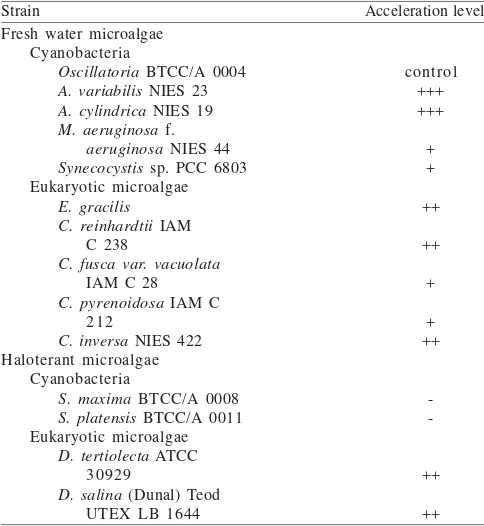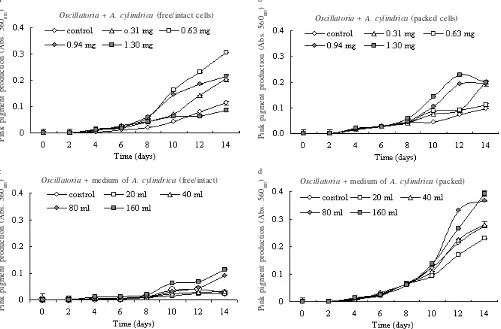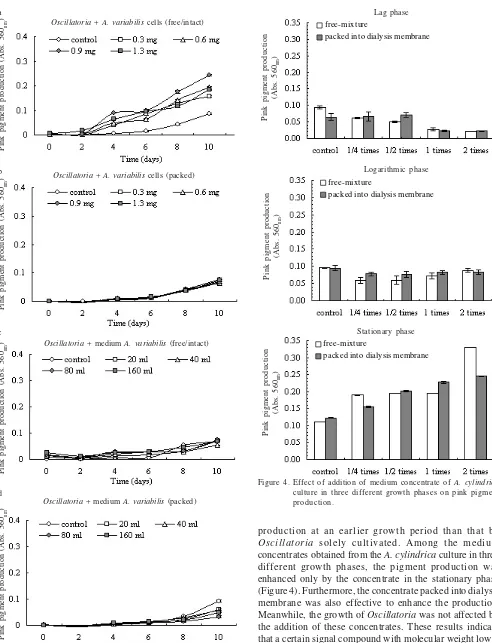Accelerating of Pink Pigment Excretion from Cyanobacterium
Oscillatoria
by Co-Cultivation with
Anabaena
DWI SUSILANINGSIH
Research Centre for Biotechnology, Indonesia Institute of Sciences, Jalan Raya Bogor Km. 46, Cibinong 16911, Indonesia Phone:+62-21-8754587, Fax: +62-21-8744588, E-mail: [email protected]
Received May 16, 2006/Accepted March 21, 2007
The freshwater cyanobacterium Oscillatoria BTCC/A 0004 excretes pink pigment containing lipoproteins with mo-lecular weights of about 10 kDa. This pigment has surfactant properties with strong emulsification activity toward several hydrocarbons. This extracellular metabolite was suspected as toxin or allelochemical in their habitat. In this study, I investigated the effect of co-cultivation of Oscillatoria with Anabaena variabilis on the pigment excretion to explore the physiological roles of this pigment in its natural environment. The dead or viable cells and medium of A. variabilis were added into Oscillatoria cultures. Results showed that co-cultivation of free viable cells of A. variabilis enhanced the excretion of pigment without effect on the cell growth. Co-cultivation with viable cells in separated method and dead cells did not influenced the pigment production. The addition of A. variabilis medium was slightly increased the excretion of the pigment. Those results indicated that direct contact with A. variabilis caused Oscillatoria released a certain signaling compound.
Key words: Oscillatoria, Anabaena variabilis, biosurfactant, cyanobacterium, pink pigment
___________________________________________________________________________ ISSN: 1978-3019
INTRODUCTION
Biosurfactants are produced by a wide variety of organisms ranging from microorganisms to plants and animals. The heterotrophic microorganisms such as bacteria, yeasts, and fungi produce surfactants with various chemical
structures and molecular weights (Navon-Venezia et al. 1995;
Desai & Banat 1997). On the other hand, biosurfactants produced by cyanobacteria (blue green algae) have not been reported so far, although they have received much attention as rich sources of bioactive compounds. However, it is expected that amphipathic extracellular metabolites frequently found in cyanobacterial cultures such as lipoproteins (Maeda
& Omata 1997), lipopeptides (Burja et al. 2002), and
lipopolysaccharides (Shah et al. 1999) will exhibit surfactant
properties.
The investigation of the pink pigment containing
lipoprotein from cyanobacterium Oscillatoria isolated from
Jatiluhur dam (West Java, Indonesia) exhibited biosurfactants properties (Susilaningsih unpublished data). In particular, it has strong emulsified hydrocarbon and high fatty acids. They were higher than commercial synthetic surfactant such as a Triton X-100. A further evaluation of the lipoprotein activities showed that the compounds were effective for inhibiting protozoa growth and paddy weed germination. However, they were less effective for antimicrobial agents (Susilaningsih 2003). The yield of crude extracellular pigment was approximately 5 g dry weight/1 l culture and 1 g of crude extracellular pigment contained approximately 52 mg of proteins.
Based on those evidences, the excretion of the compounds by Oscillatoria may act as an anti protozoa or an allelochemical
agents in their natural environments. The interaction between two organisms usually produce some compounds which sometimes could be active compounds to protect their life. Therefore, the aim of this study is to elucidate this phenomenon, by conducting co-cultivation experiments.
MATERIALS AND METHODS
Cultivation Conditions of Oscillatoria. Oscillatoria
BTCC/A 0004 was cultivated in 80 ml of modified C medium in a petri dish (150 mm in diameter; 15 mm in depth; Becton Dickinson, Falcon, USA). The medium consisted of (per
liter); 5 g KNO3, 0.1 g KH2PO4, 0.05 g MgSO4·7H2O, 0.005 g
FeCl2, 2.86 mg H3BO3, 1.81 mg MnCl2·4H2O, 0.22 mg
ZnSO4·7H2O, 0.018 mg (NH4)6Mo7O24·4H2O, and 0.075 mg
CuSO4·5H2O (pH 7.5). The initial cell concentration was
adjusted to an optical density of 0.05 at 680 nm (OD680nm). An
OD680 nm value of 1 is equal to 13 mg dry cell weight/ml. The dish was placed in a transparent cultivation box and incubated
at 25 oC under aeration containing 1% CO
2 at 4 ml/min and
illuminated with 30 W/m2 white fluorescent light. Cell growth
was monitored by measuring OD680 nm of the culture sampled
at indicated times.
Preliminary Test of Oscillatoria Co-Cultivation with Several Microalgae. Freshwater cyanobacteria, Anabaena cylindrica NIES 19, A. variabilis NIES 23, Microcystis aeruginosa f. aeruginosa NIES 44, and Synecocystis sp. PCC 6803 were grown in modified BG 11 medium. Freshwater
eukaryotic algae, Euglena gracilis (Osaka Prefecture
University collection), Chlamydomonas reinhardtii IAM C
238, Chlorella fusca var. vacuolata IAM C 28, C. pyrenoidosa
Bristol modified medium. Euglena gracilis was grown in Bold
basal medium. Halotolerant cyanobacteria, Spirulina maxima
BTCC/A 0008 and S. platensis BTCC/A 0011, and halotolerant
green algae, Dunaliella tertiolecta ATCC 30929 and D. salina
(Dunal) Teod UTEX LB 1644, were grown in Zarrouk medium and F-2 medium, respectively.
All algae were pre-cultivated in 200 ml of their respective media in a test tube (40 mm in diameter) under aeration
containing 1% CO2 at 30 ml/min and illuminated with 30
W/m2 white fluorescent light. The cells were harvested in the
exponential phase and resuspended in fresh medium at a
concentration that gave an OD 680 nm of 0.1. Two milliliters of
the cell suspension was transferred into a 24-well culture plate (Becton Dickinson, Falcon, USA) and then 0.1, 0.5, or 1of
final OD680nm of fresh Oscillatoria cells was added and
cultivated under the same conditions as those for
Oscillatoria. The cells were monitored by cell counting number under microscope and the extracellular pigment was measured by spectrophotometer at ë 560 nm three times during cultivation.
Co-Cultivation of Oscillatoria with Anabaena. Anabaena variabilis and A. cylindrica, were used to stimulate pigment
production by Oscillatoria. Anabaena was cultivated in
200 ml of culture vessel in BG 11 medium. In the logarithmic phase, the cells and medium were separated and both of the materials were collected. Both of the cells and medium were intact directly inoculated or packed in dialysis membrane (Seamless Cellulose Tubing, Viskase Sales Corp, Japan) to separate substances which having molecular weights higher than 7000 Dalton. The amounts of the cells were about 0, 0.3, 0.6, 0.9, and 1.3 mg cells/ml cultures. Concentration of the medium were 0, 20, 40, 80, and 160 ml/200 ml cultures. The experiments were conducted in triplicate and pigment production was monitored every two days by measuring absorbance at ë 560 nm.
In further treatment, Oscillatoria was cultivated in the
presence of A. cylindrica culture. The concentrate was
prepared by lyophilization of the culture medium in lag (3-day-old), logarithmic (8-(3-day-old), and stationary (14-day-old)
growth phases.The amounts of introduced media were about
0.25, 0.50, 100, and 200% volume of Oscillatoria cultures.
The experiments were conducted in triplicate and pigment production was monitored every two days by measuring absorbance at ë 560 nm. Cells were harvested at the end of cultivation and cell growth was evaluated in terms of dry cell weight.
RESULT
Cultivation Conditions of Oscillatoria sp. The pigment
from Oscillatoria was released in the exponential phase, then
suddenly decreased after 16 days (Figure 1). The maximum production of pink pigment was approximately 5 g dry weight 1 l culture. The pink pigment was consisting of 75% protein and 25% lipid (lipoprotein).
Preliminary Test of Co-Cultivation of Oscillatoria with Several Microalgae. The co-cultivation of Oscillatoria and
several prokaryotic microalgae (Microcystis, Synecocystis, and
Spirulina) showed that they did not or less accelerate the
pink pigment production (Table 1). However, Dunaliella
accelerated the pink pigment production and Anabaena
highly accelerated the pink pigment production (Table 1). In
addition, the results of co-cultivation the Oscillatoria with
the eukaryotic microalgae showed the consortia accelerated the pink pigment production. To seek further information
specific co-cultivation Oscillatoria with Anabaena was
attempted.
Co-Cultivation of Oscillatoria with Anabaena.
Co-cultivation Oscillatoria with A. cylindrica showed that the
addition of intact (free) cells and packed cells in dialysis
tube of A. cylindrica, both enhanced the pink pigment
production (Figure 2a, b). The highest enhancement of the
pink pigment production treated by free cells in Oscillatoria
cultures was the 0.63 mg cells of A. cylindrica. That resulted
Table 1. Acceleration of pink pigment production by Oscillatoria sp. by various microalgae
Strain Acceleration level Fresh water microalgae
Cyanobacteria
Oscillatoria BTCC/A 0004
A. variabilis NIES 23
A. cylindrica NIES 19
M. aeruginosa f.
aeruginosa NIES 44
Synecocystis sp. PCC 6803 Eukaryotic microalgae
E. gracilis C. reinhardtii IAM
C 238
C. fuscavar. vacuolata
IAM C 28
C. pyrenoidosa IAM C 212
C. inversa NIES 422 Haloterant microalgae
Cyanobacteria
S. maxima BTCC/A 0008
S. platensis BTCC/A 0011 Eukaryotic microalgae
D. tertiolecta ATCC 30929
D. salina (Dunal) Teod UTEX LB 1644 -: no acceleration, +: less acceleration, ++: acceleration, +++: high acceleration
Figure 1. Time courses of growth and pink pigment production in
Oscillatoria
Pink pigment production (Abs. 560 nm)
in addition at production around 0.2 (Absorbance ë 560nm) unit (Figure 2a). In the second treatment, the addition of
1.30 mg packed cells of A. cylindrica in Oscillatoria culture
gave the highest result, i.e. + 0.22 (Figure 2b). In both treatment, almost all of the highest productions were achieved in the
late exponential phase of Oscillatoria growth (Figure 2a, b).
The addition of A. cylindrica used media into Oscillatoria
cultures showed that the media packed in the dialysis membrane enhanced the pink pigment production (Figure 2d). The highest yield was shown in the culture medium resulted 0.3-0.4 pink pigment production unit. However, the free/intact media addition treatments did not influence the pink pigment production (Figure 2c).
The further effect of the A. variabilis was investigated in
the next experiments. The addition of A. variabilis in
Oscillatoria cultures showed that only the free cells (intact) treatments enhanced the pink pigment production (Figure 3a-d). The highest result was achieved by concentration of 1.3 mg free cells addition, which is around 0.23 (Figure 3a). Therefore, for further investigation only co-cultivation with
A. cylindrica was observed.
The addition of lyophilized A. cylindrica medium in
Oscillatoria cultures showed that stationary phase of the
Anabaena accelerated the pink pigment production, both of free and packed cells in dialysis tube treatments (Figure 4). The highest culture concentration gave the highest result, i.e. 0.2-0.31.
DISCUSSION
To investigate the allelopathic function of the pigment,
Oscillatoria was co-cultivated with several freshwater cyanobacteria and green algae that are commonly found in aquatic environments in Southeast Asia. Among them, only
co-cultivation with Anabaena of both A. cylindrica and A.
variabilis markedly enhanced the pigment production (Table
1). Growth of Oscillatoria in presence of other algae was
slightly suppressed compare to cultivated alone.According
to Demain and Fang (2000), secondary metabolites are useful as competitive weapons.
Further investigation was mainly using Anabaena.
Anabaena cylindrica cells packed in the dialysis membrane enhanced the pink pigment production (Figure 2b), whereas
packed A. variabilis cells exhibited no enhancement (Figure
3b). The growth of Oscillatoria co-cultivated with these two
strains was slightly suppressed but not very different from
that of Oscillatoria cultivated solely. These results indicate
that A. variabilis requireds direct cell contact with Oscillatoria
for the enhancement of pigment production, whereas A.
cylindrica does not require the direct contact. Two hypotheses could explain the enhancement of pigment production by the
packed A. cylindrica cells. One is the enhancement by a certain
signaling substance released by this species. Another hypothesis is that the changes in medium composition as a result of consumption by co-existing algae trigger pigment
Figure 2. Effect of co-cultivation Oscillatoria with A. cylindrica on pink pigment production. a. Free cells treatments, b. Packed cells in dialysis membrane treatments, c. Free/intact media treatments, d. Packed media in dialysis membrane treatments.
Oscillatoria + medium of A. cylindrica (free/intact) c
Oscillatoria + A. cylindrica (packed cells) b
Oscillatoria + medium of A. cylindrica (packed) d
Oscillatoria + A. cylindrica (free/intact cells) a
Pink pigment production (Abs. 560
nm
)
Pink pigment production (Abs. 560
nm
)
Pink pigment production (Abs. 560
nm
)
Pink pigment production (Abs. 560
nm
free-mixture
packed into dialysis membrane
Pink pigment production
(Abs. 560
nm
)
Stationary phase
free-mixture
packed into dialysis membrane
Pink pigment production
(Abs. 560
nm
)
Lag phase
free-mixture
packed into dialysis membrane
Pink pigment production
(Abs. 560
nm
)
Logarithmic phase
Figure 4. Effect of addition of medium concentrate of A. cylindrica
culture in three different growth phases on pink pigment production.
Figure 3. Effect of co-cultivation Oscillatoria sp. with A. variabilis on pink pigment production. a. Free cells (intact) treatments, b. Packed cells treatments, c. Free/intact media treatments, d. Packed media treatments.
Oscillatoria + medium A. variabilis (packed) d
Oscillatoria + medium A. variabilis (free/intact) c
Oscillatoria + A. variabilis cells (packed) b
Oscillatoria + A. variabilis cells (free/intact) a
Pink pigment production (Abs. 560
nm
)
Pink pigment production (Abs. 560
nm
)
Pink pigment production (Abs. 560
nm
)
Pink pigment production (Abs. 560
nm
)
production at an earlier growth period than that by
Oscillatoria solely cultivated. Among the medium
concentrates obtained from the A. cylindrica culture inthree
different growth phases, the pigment production was enhanced only by the concentrate in the stationary phase (Figure 4). Furthermore, the concentrate packed into dialysis membrane was also effective to enhance the production.
Meanwhile, the growth of Oscillatoria was not affected by
the addition of these concentrates. These results indicate that a certain signal compound with molecular weight lower
than 7000 was released by A. cylindrica and may cause
product in response to a signaling substance released by the
co-existing A. cylindrica.
Previous experiment showed that the pink pigment exhibited allelopathy function towards specific microalgae and bacteria with minimum inhibitory concentration ranging from
1-10 µM (Susilaningsih 2003). Along with the determination
of the chemical structure of the pigment which has specific surfactant function, this information would be useful for its potential application as a pink pigment or an antibiotic compound. The pigment is suggested as an allelochemical-like function towards other organisms such as cyanobacteria
breeding with Oscillatoria in natural aquatic environment.
More detailed analysis of this unique phenomenon would give useful information to clarify allelopathic function in aquatic photosynthetic microorganisms. Furthermore, the enhancement of pigment production using allelopathic effect
would be effective technique for the cultivation of Oscillatoria
to supply the pigment for its practical application. Further investigation to determine the signal compound and its enhancing mechanism is in progress.
ACKNOWLEDGEMENT
This work was supported by Environmental Bioengineering Laboratory, Graduate School of Pharmaceutical Sciences, Osaka
University, Japan. I would like to thanks to Kazuhisa Miyamoto and Kazumasa Hirata for their support and discussion.
REFERENCES
Burja AM et al. 2002. Culture of the marine cyanobacterium, Lyngbya majuscula (Oscillatoriaceae), for bioprocess intensified production of cyclic and linear lipopeptides. J Microbiol Methods 48:207-219.
Demain LA, Fang A. 2000. The natural functions of secondary metabolites. Advances in Biochem Engineering/Biotechnol 69:6-34.
Desai JD, Banat IM. 1997. Microbial production of surfactant and their commercial potential. Microbiol Mol Biol Rev 61:47-64. Maeda SI, Omata T. 1997. Substrate-binding lipoprotein of the
cyanobacterium Synechococcus sp. strain PCC 7942 involved in the transport of nitrate and nitrite. J Biol Chem 272:3036-3042. Navon-Venezia S et al.1995. Alasan, a new bioemulsifier from
Acetinobacter radioresistens. Appl Environ Microbiol 61:3240-3244.
Shah V, Garg N, Madamwar D. 1999. Exopolysaccharide production by marine cyanobacterium Cyanothece sp. Appl Biochem Biotechnol 82:82-91.


